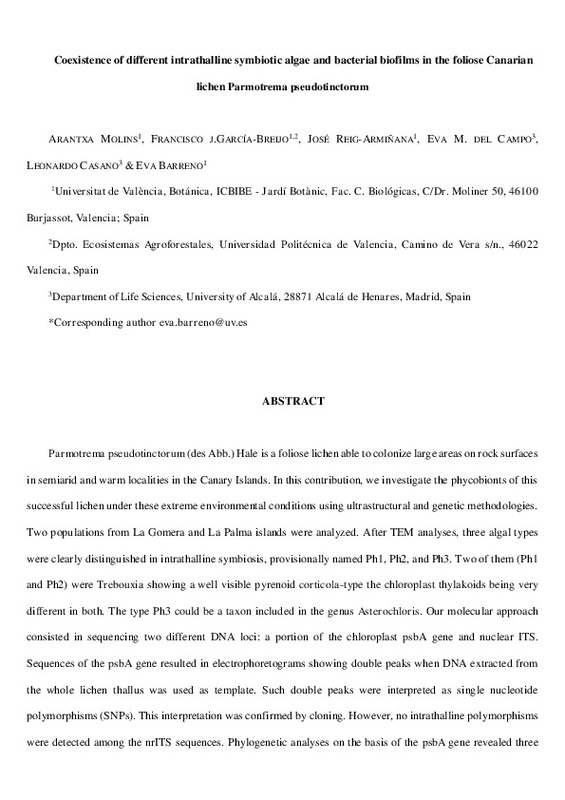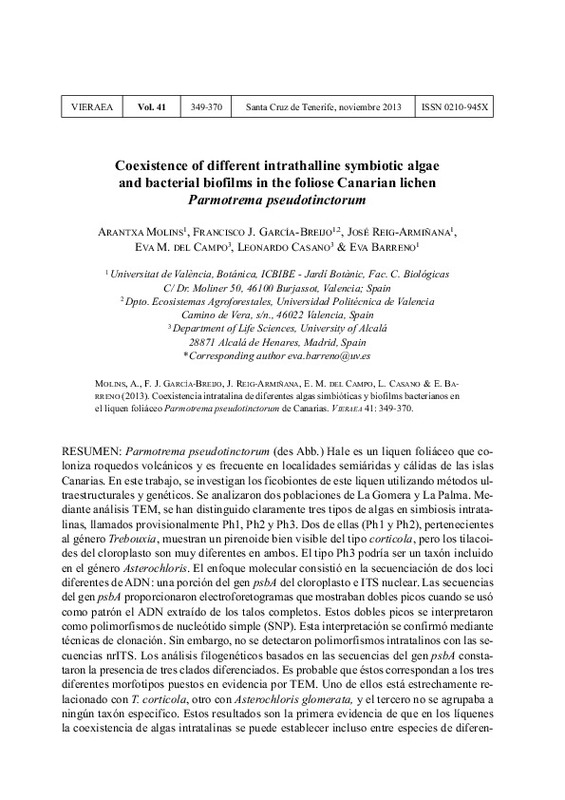JavaScript is disabled for your browser. Some features of this site may not work without it.
Buscar en RiuNet
Listar
Mi cuenta
Estadísticas
Ayuda RiuNet
Admin. UPV
Coexistence of different intrathalline symbiotic algae and bacterial biofilms in the foliose Canarian lichen Parmotrema pseudotinctorum
Mostrar el registro sencillo del ítem
Ficheros en el ítem
| dc.contributor.author | Molins, Arantxa
|
es_ES |
| dc.contributor.author | García-Breijo, Francisco-José
|
es_ES |
| dc.contributor.author | Reig Armiñana, José
|
es_ES |
| dc.contributor.author | Del Campo, Eva M.
|
es_ES |
| dc.contributor.author | Casano, Leonardo
|
es_ES |
| dc.contributor.author | Barreno Rodriguez, Eva
|
es_ES |
| dc.date.accessioned | 2017-01-26T09:04:33Z | |
| dc.date.available | 2017-01-26T09:04:33Z | |
| dc.date.issued | 2013 | |
| dc.identifier.issn | 0210-945X | |
| dc.identifier.uri | http://hdl.handle.net/10251/77348 | |
| dc.description.abstract | [EN] Parmotrema pseudotinctorum (des Abb.) Hale is a foliose lichen able to colonize large areas on rock surfaces in semiarid and warm localities in the Canary Islands. In this contribution, we investigate the phycobionts of this successful lichen under these extreme environmental conditions using ultrastructural and genetic methodologies. Two populations from La Gomera and La Palma islands were analyzed. After TEM analyses, three algal types were clearly distinguished in intrathalline symbiosis, provisionally named Ph1, Ph2, and Ph3. Two of them (Ph1 and Ph2) were Trebouxia showing a well visible pyrenoid corticolatype the chloroplast thylakoids being very different in both. The type Ph3 could be a taxon included in the genus Asterochloris. Our molecular approach consisted in sequencing two different DNA loci: a portion of the chloroplast psbA gene and nuclear ITS. Sequences of the psbA gene resulted in electrophoretograms showing double peaks when DNA extracted from the whole lichen thallus was used as template. Such double peaks were interpreted as single nucleotide polymorphisms (SNPs). This interpretation was confirmed by cloning. However, no intrathalline polymorphisms were detected among the nrITS sequences. Phylogenetic analyses on the basis of the psbA gene revealed three distinct clades. It is likely that these clades corresponded to the the three different morphotypes revealed by TEM. One of these clades, was closely related to T. corticola, other was related to Asterochloris glomerata and the third did not grouped with any specific taxa. These results are the first piece of evidence that algal coexistence may even be established between species of different genera of the Trebouxiophyceae (Asterochloris and Trebouxia at least). Moreover, the coexistence of several microalgal taxa evidenced in this study appears as a consistent character among the populations of this foliose lichen. Further isolation and cultivation of the three different algal types and physiological studies should shed light on the ecological plasticity of the entire holobiont. Along with such variety of intrathalline coexisting algae, another unexpected result was the observation of an almost continuous layer of bacterial-communities coating the lower cortex in all the studied samples of P. pseudotinctorum. The function of these biofilms in the lichen symbiosis remains to be elucidated. The existence of such particular symbiosis involving different algal species and bacteria could be explained by an increased fitness in particular habitats or under specific environmental conditions | es_ES |
| dc.description.abstract | [ES] Parmotrema pseudotinctorum (des Abb.) Hale es un liquen foliáceo que coloniza roquedos volcánicos y es frecuente en localidades semiáridas y cálidas de las islas Canarias. En este trabajo, se investigan los ficobiontes de este liquen utilizando métodos ultraestructurales y genéticos. Se analizaron dos poblaciones de La Gomera y La Palma. Mediante análisis TEM, se han distinguido claramente tres tipos de algas en simbiosis intratalinas, llamados provisionalmente Ph1, Ph2 y Ph3. Dos de ellas (Ph1 y Ph2), pertenecientes al género Trebouxia, muestran un pirenoide bien visible del tipo corticola, pero los tilacoides del cloroplasto son muy diferentes en ambos. El tipo Ph3 podría ser un taxón incluido en el género Asterochloris. El enfoque molecular consistió en la secuenciación de dos loco diferentes de ADN: una porción del gen psbA del cloroplasto e ITS nuclear. Las secuencias del gen psbA proporcionaron electroforetogramas que mostraban dobles picos cuando se usó como patrón el ADN extraído de los talos completos. Estos dobles picos se interpretaron como polimorfismos de nucleótido simple (SNP). Esta interpretación se confirmó mediante técnicas de clonación. Sin embargo, no se detectaron polimorfismos intratalinos con las secuencias nrITS. Los análisis filogenéticos basados en las secuencias del gen psbA constataron la presencia de tres clados diferenciados. Es probable que éstos correspondan a los tres diferentes morfotipos puestos en evidencia por TEM. Uno de ellos está estrechamente relacionado con T. corticola, otro con Asterochloris glomerata, y el tercero no se agrupaba a ningún taxón especifico. Estos resultados son la primera evidencia de que en los líquenes la coexistencia de algas intratalinas se puede establecer incluso entre especies de difierentes géneros de Trebouxiophyceae (Asterochloris y Trebouxia al menos). Por otra parte, la coexistencia de varios taxones de microalgas, constatada en este estudio, puede considerarse como una sólida característica entre las poblaciones de este liquen foliáceo. Posteriores aislamientos y el cultivo de los tres tipos de algas, además de estudios fisiológicos, podrán explicar la plasticidad ecológica que muestra el holobionte. Otro resultado inesperado fue la observación de una capa casi continua de comunidades bacterianas que recubren el córtex inferior en todas las muestras estudiadas de P. pseudotinctorum. Está por determinar la función que estos biofilms puedan tener en las simbiosis liquénicas. La existencia de estos tipos de simbiosis tan particulares, que involucran tanto a diferentes especies de algas como a bacterias, podría explicarse por un incremento en la capacidad de colonizar hábitats peculiares o con condiciones ambientales específicas | es_ES |
| dc.description.sponsorship | This study was funded by the Spanish Ministry of Economy and Innovation (MINECO CGL2012-40058-C02-01/02), FEDER and the Generalitat Valenciana (PROMETEO 021/2013 GVA). | |
| dc.language | Español | es_ES |
| dc.publisher | Organismo Autónomo de Museos y Centros del Cabildo de Tenerife | es_ES |
| dc.relation.ispartof | Vieraea. Folia Scientarum Biologicarum Canariensium | es_ES |
| dc.rights | Reserva de todos los derechos | es_ES |
| dc.subject | Microalga | es_ES |
| dc.subject | Ficobionte | es_ES |
| dc.subject | ITS nuclear | es_ES |
| dc.subject | PsbA cloroplásto | es_ES |
| dc.subject | Anatomía | es_ES |
| dc.subject | Ultraestructura | es_ES |
| dc.subject | Análisis ML | es_ES |
| dc.subject | MP, NJ | es_ES |
| dc.subject | Islas Canarias | es_ES |
| dc.subject | Microalgae | es_ES |
| dc.subject | Phycobiont | es_ES |
| dc.subject | Trebouxiophyceae | es_ES |
| dc.subject | Nuclear ITS | es_ES |
| dc.subject | Chloroplast psb | es_ES |
| dc.subject | Anatomy | es_ES |
| dc.subject | Ultrastructure | es_ES |
| dc.subject | ML | es_ES |
| dc.subject | MP | es_ES |
| dc.subject | NJ analyses | es_ES |
| dc.subject | Canary Islands | es_ES |
| dc.subject.classification | BOTANICA | es_ES |
| dc.subject.classification | BIOLOGIA VEGETAL | es_ES |
| dc.title | Coexistence of different intrathalline symbiotic algae and bacterial biofilms in the foliose Canarian lichen Parmotrema pseudotinctorum | es_ES |
| dc.type | Artículo | es_ES |
| dc.relation.projectID | info:eu-repo/grantAgreement/MINECO//CGL2012-40058-C02-02/ES/COEXISTENCIA DE DIFERENTES MICROALGAS EN UN MISMO TALO: POSIBLES IMPLICACIONES SOBRE EL FUNCIONAMIENTO Y CAPACIDAD ADAPTATIVA DE LAS SIMBIOSIS LIQUENICAS/ | es_ES |
| dc.relation.projectID | info:eu-repo/grantAgreement/MINECO//CGL2012-40058-C02-01/ES/COEXISTENCIA DE DIFERENTES MICROALGAS EN UN MISMO TALO: POSIBLES IMPLICACIONES SOBRE EL FUNCIONAMIENTO Y CAPACIDAD ADAPTATIVA DE LAS SIMBIOSIS LIQUENICAS/ | es_ES |
| dc.relation.projectID | info:eu-repo/grantAgreement/GVA//PROMETEO%2F2013%2F021/ | es_ES |
| dc.rights.accessRights | Abierto | es_ES |
| dc.contributor.affiliation | Universitat Politècnica de València. Escuela Técnica Superior de Ingeniería Agronómica y del Medio Natural - Escola Tècnica Superior d'Enginyeria Agronòmica i del Medi Natural | es_ES |
| dc.description.bibliographicCitation | Molins, A.; García-Breijo, F.; Reig Armiñana, J.; Del Campo, EM.; Casano, L.; Barreno Rodriguez, E. (2013). Coexistence of different intrathalline symbiotic algae and bacterial biofilms in the foliose Canarian lichen Parmotrema pseudotinctorum. Vieraea. Folia Scientarum Biologicarum Canariensium. 41:349-370. http://hdl.handle.net/10251/77348 | es_ES |
| dc.description.accrualMethod | S | es_ES |
| dc.relation.publisherversion | http://www.museosdetenerife.org/assets/downloads/publication-939927b41d.pdf | es_ES |
| dc.description.upvformatpinicio | 349 | es_ES |
| dc.description.upvformatpfin | 370 | es_ES |
| dc.type.version | info:eu-repo/semantics/publishedVersion | es_ES |
| dc.description.volume | 41 | es_ES |
| dc.relation.senia | 254111 | es_ES |
| dc.contributor.funder | Ministerio de Economía y Competitividad | |
| dc.contributor.funder | Generalitat Valenciana |







